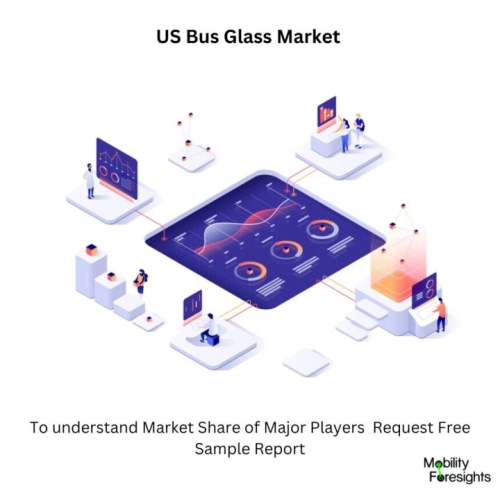
- Get in Touch with Us

Last Updated: Apr 25, 2025 | Study Period:
The Bus Glass market is termed as special glass manufacturing and selling used in various types of buses, such as city buses, school buses, and long-distance coaches. The safety, durability, and visibility of these kinds of glasses are inbuilt into the design, while added features of toughened or laminated glasses provide protection in case of accidents.
Key characteristics involved are resistance to shattering, UV protection, and sometimes integrated functions like heating elements that support defrosting. Safety legislation, changes in technology, and the rising demands on passenger comfort keep up the demand for high-quality bus glass.
Applications of bus glass go beyond the field of vision for drivers and passengers. The glass used in buses must endure constant exposure to environmental factors like heat, cold, and impact. Specialized glass is used not only for side and rear windows but also for front windshields and even roof panels in some cases, or even panoramic or custom-designed glass configurations.
Other factors contributing to the market growth include a rise in electric and autonomous buses, raising demand for more sophisticated glazing solutions that have integrated sensors and cameras for better automation and safety systems in vehicles to raise energy efficiency.
Several factors contribute to the growth of the bus glass market. The increasing focus on passenger comfort and safety remains key factors towards industry productions of better technologies of glass such as toughened or tempered and laminated glass that ensures greater protection in case of accidents. The increase in electric and autonomous buses is also driving the market to adopt more innovative glass solutions for better energy efficiency and integration with sensors and cameras.
In addition, urbanization and the growing requirement for public transport, especially in developing markets, propel further growth in the demand for bus glass when municipal fleets are upgraded or expanded to accommodate growing populations. However, there are some risk factors which might occur in the market. One of the most critical risks is that stricter government regulations with regard to manufacturing standards might increase the cost for producers.
Although such regulations could help improve safety and environmental performance, their compliance might be capital-intensive, given that new technologies or processes need to be put in place.
Other ongoing challenges include price volatility within key raw materials such as glass and related components, which may affect supply chains and production costs. Besides, demand for new buses might be significantly influenced by economic uncertainties or slowdowns in key markets, thus consequently constraining the growth of the bus glass market.
Glass demand in the U.S. bus market is relatively significant, considering a wide range and fleet size of public transportation, school buses, and coaches traveling over long distances.

The continuous growth in the market size is because of upgrading public transit systems by cities to meet regulatory safety requirements and modernization of fleets. School buses are one of the major segments in this industry, mainly due to the rigid safety requirements imposed on glazing materials in this application, which often render them for replacement.
In addition, large urban centers with heavy public transport use-places like New York, Chicago, and Los Angeles-will be the hubs where demand for bus glass remains exceedingly high.
The newly designed buses require new glass materials to be lightweight and energy-efficient, and in many applications, they are incorporating sensors or increased thermal insulation.
With the school and transit bus markets already well established, it leaves untapped potential in the sectors of the market for luxury coaches and tour buses, where premium glass products, such as bespoke windows or panoramic roofs, are becoming increasingly popular.
| Sl No | Company | Product Description | Analyst View |
| 1. | Guardian Glass | MVA-BN: A smallpox vaccine repurposed for monkeypox. Uses a modified vaccinia virus. | Bavarian Nordic's launch of MVA-BN leverages existing smallpox vaccine technology, aiming to provide targeted protection against monkeypox. Its proven safety profile and effectiveness in related diseases make it a strategic choice to address outbreaks. |
| 2. | Pilkington North America | LC16: A live attenuated smallpox vaccine adapted for monkeypox. | LC16's introduction highlights the use of a time-tested smallpox vaccine with modifications to enhance safety and efficacy for monkeypox. Its launch reflects a need for established solutions to manage monkeypox outbreaks effectively. |
| 3. | AGC Automotive | Tecovirimat (TPOXX): An antiviral initially developed for smallpox, now considered for monkeypox treatment. | Tecovirimatâs potential use for monkeypox reflects its broader application for orthopoxvirus infections. Its approval for smallpox and ongoing studies for monkeypox suggest a strategic extension of its use to manage and treat monkeypox outbreaks. |
| 4. | Fuyao Group |
By Application
By Sales
By Bus Type
The U.S. bus glass market is characterized by a competitive landscape with several key players, including companies like Saint-Gobain, AGC Glass, Pilkington (NSG Group), and Guardian Glass. These firms offer a range of products such as laminated, tempered, and heated bus glass to address varying safety and performance needs.
Saint-Gobain and AGC Glass focus on innovation with advanced glass technologies, including UV protection and energy-efficient coatings. Pilkington emphasizes durable and impact-resistant glass solutions, while Guardian Glass offers a broad product range with a focus on cost-effectiveness.
The market shows active mergers and acquisitions, with companies consolidating to enhance their technological capabilities and expand market reach. Pricing differences often stem from the technology used in the glass, such as added safety features or energy efficiency, and the economies of scale achieved by larger manufacturers. Strategic partnerships and investments in R&D are common as companies aim to differentiate themselves in a competitive market.
| Sl no | Topic |
| 1 | Market Segmentation |
| 2 | Scope of the report |
| 3 | Abbreviations |
| 4 | Research Methodology |
| 5 | Executive Summary |
| 6 | Introduction |
| 7 | Market Dynamics |
| 8 | Market Size and Forecast |
| 9 | Technological Innovations in US Bus glass Market |
| 10 | New Product Launched in US Bus glass Market |
| 11 | Economic Factors Affecting the Market |
| 12 | Sustainability and Environmental Impact |
| 13 | Impact of R&D on Market Growth |
| 14 | Regulatory and Safety Standards |
| 15 | Factors Influencing Pricing |
| 16 | Market Size, Dynamics and Forecast by Geography, 2024-2030 |
| 17 | Market Size, Dynamics and Forecast by Application, 2024-2030 |
| 18 | Market Size, Dynamics and Forecast by OEM, 2024-2030 |
| 19 | Market Size, Dynamics and Forecast by Bus Type, 2024-2030 |
| 20 | Future Trends and Market Outlook |
| 21 | Mergers and Acquisitions |
| 22 | Competitive Landscape |
| 23 | Growth strategy of leading players |
| 24 | Market share of vendors, 2023 |
| 25 | Company Profiles |
| 26 | Unmet needs and opportunity for new suppliers |
| 27 | Conclusion |